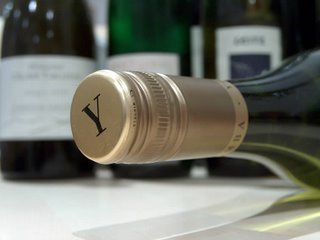Recent coverage of screwcap faults
 I mentioned earlier my disap- pointment about how the 'screwcaps fault' issue has been treated in the press. My response is now online.
I mentioned earlier my disap- pointment about how the 'screwcaps fault' issue has been treated in the press. My response is now online.The Wine+ closures talk I did yesterday was OK. Well enough attended, but I reckon I rushed through my material a bit. Always hard to know how you did when you are presenting technical stuff to a largely non-techie audience; I think I judged some bits well, some badly.
Caught up with Tony Jordan again and tasted the Cloudy Bay and Cape Mentelle ranges. Also tried Vickbar's excellent Greek range.
Labels: closures


6 Comments:
Excellent article Jamie. I have to say the level of reasoned debate around the closures issue is fairly low in the popular press at the best of times. What I don't quite understand in this case is why the issue raised it's head now given that the statistics on faults in screwcapped wines in the IWC were well publicised months ago.
Jeremy
Good article. Never get a journalist to do the job of a scientist.
There's a good investigative piece for someone here. I think you're right that this press flurry reads like it came from a press release. I think we all probably suspect who sent the release, but it'd be good to dig up the evidence anyway.
Thor, it's not Amorim - I'm pretty sure of that.
But there are other natural cork interests.
I think I know the journalistic contact behind most of these stories, but this isn't 'investigative journalism'.
Jeremy - quite agree.
Stephen, thanks for the comment.
Great article Jamie - just what the doctor ordered. Your trumpeting of proper science over headline grabbing distortions is much needed with the wine/health debate as well as this closure issue.
Am I being too cynical when I believe that the timing of this issue is quite obvious? Northern hemisphere winemakers are now starting to think about bottling some of their 2006 wines (as Jamie's own bottle delivery confirms!). If the cork lobby can get UK drinkers to reject screw caps then this will scare the winemakers into sealing their bottles with screwies.
It can be too easy to get consumer obsessed here and think that the only thing to consider is whether one's bottle of wine is TCA-free or not. The global closure industry is a big one, worth big money and lots of peoples jobs (Jamie, have you got any figures?). I'm not saying we should put up with faulty wines, but don't think either that the businesses involved are going to take criticism lying down.
Keep up the good work.
I'm not sure that you can blame the cork industry for the fact that tasters at the International Wine Challenge rejected a certain proportion of wines for being reductive. The journalism that has followed this piece of very old news, however, has been lazy and ill-informed.
The cork/stelvin debate has been over-simplified because it is so adversarial and perfectly valid scientific positions have been obfuscated by propaganda. Firstly, it never was just a question of cork vs stelvin, but of the nature of wine closures and the high incidence of wine faults under those individual closures. Secondly, the faults that are apparent under stelvin (reduction, mercaptans) are also to be found under cork. Equally, it is possible to find examples of TCA in screwcap wines.
Thirdly, the nature of wine faults is that some are perceived as "absolute" such as TCA, whilst others are viewed as relative - in that certain allowances are made for ethyl mercaptans & some of the disulphides when they are less obtrusive.
Surely, it is in the interest of the cork industry to eradicate TCA and for winemakers in general to overcome the many types of faults that bedevil wines under all closures. As a consumer I would neither want to drink a wine with cork taint nor one wherein the fruit had been masked by obtrusive aromas of sulphur compounds.
Post a Comment
Links to this post:
Create a Link
<< Home